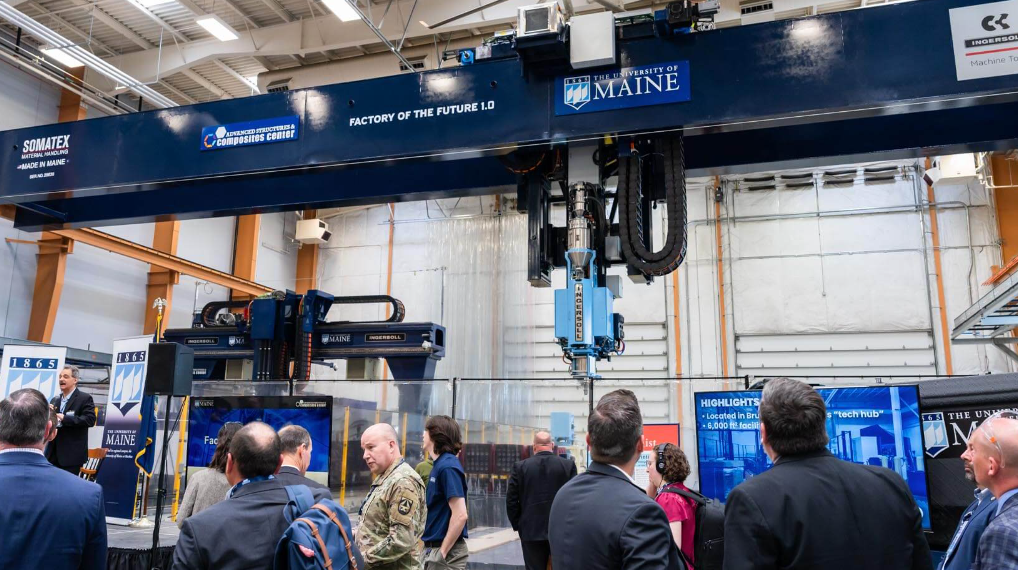Join the Expert Committee for the 2024 3D Printing Industry Awards to help select the winners!
The University of Maine (UMaine) has demonstrated a thermoplastic polymer 3D printer dubbed, Factory of the Future 1.0 (FoF 1.0) at the Advanced Structures and Composites Center (ASCC).
This 3D printer is said to be four times larger than its predecessor for which UMaine secured a Guinness World Record in 2019. With dimensions capable of printing objects up to 96 ft long by 32 ft wide by 18 ft high and a printing capacity of up to 500 pounds per hour, the FoF 1.0 promises to enhance efficiency and innovation in manufacturing research. Supported by the Office of the Secretary of Defense through the U.S. Army Corps of Engineers, its adaptability enables seamless transitions between different manufacturing processes, including large-scale additive manufacturing, subtractive manufacturing, continuous tape layup, and robotic arm operations.
“UMaine and the Advanced Structures and Composites Center possess the innovation, capacity, and workforce to support the future needs of the Department of Defense in advanced manufacturing,” said, U.S. Senator Susan Collins. “This is a great day for our University, our State, and our Nation. I congratulate President Joan Ferrini-Mundy and Dr. Habib Dagher on another important milestone and look forward to witnessing this Center’s continued innovation that is invaluable to our national security.”
Since fiscal year 2022, Senator Collins, Vice Chair of the Senate Appropriations Committee and Subcommittee on Defense, has secured over $93 million in funding to bolster this initiative and other defense projects at the ASCC.
UMaine’s progress over the years
Following the launch of FoF 1.0, UMaine is establishing the Green Engineering and Materials (GEM) Factory of the Future, a 47,000 sq ft research facility opening in August. The GEM Factory will focus on sustainable manufacturing practices and explore innovative materials, prioritizing recycled and bio-based options from Maine’s forestry industry.
The GEM Factory of the Future complements UMaine’s broader efforts, like the Maine College of Engineering and Computing (MCEC), supported by the Harold Alfond Foundation’s UMS TRANSFORMS initiative. These initiatives prioritize developing a skilled workforce and industry-academia collaboration to prepare future leaders for a digital and global economy.
Back in 2022, UMaine’s Advanced Structures and Composites Center in Orono 3D printed two large-scale boats, one of which was claimed as the largest ever additively manufactured. Developed for the U.S. Marine Corps, the vessels served as logistical support and underwent field testing. The larger craft accommodates two 20-foot shipping containers, while the other transport a rifle squad with three days’ provisions.
A year before this, UMaine received $2.8 million from the U.S. Department of Energy (DoE) to develop an eco-friendly 3D printing method for wind turbine blade molds. In doing so, UMaine aimed to cut costs by 50% by incorporating bio-based material into its CNF printing process. In collaboration with Oak Ridge National Laboratory (ORNL), the project involved integrating 3D printed heating elements. The objective was to expedite the R&D of green energy technologies, particularly in wind power.
University-developed 3D printers
UMaine says its FoF 1.0 3D printer is set to support various initiatives, including the exploration of biobased feedstocks sourced from abundant wood residuals in Maine. This technology is expected to drive forward commercialization efforts such as BioHome3D and contribute to the development of sustainable, cost-effective housing solutions. Additionally, it is anticipated to foster technological improvements relevant to national security, particularly in lightweight, rapidly deployable structures, and vessel technologies.
“The Maine College of Engineering and Computing is proud to be a strong partner in developing the Factory of the Future 1.0. This partnership brings together engineering and material technologies together with advanced computing, creating unprecedented hands-on learning experiences in advanced manufacturing for our students and providing venues to develop new classes, electronic credentials and new majors,” said, Giovanna Guidoboni, inaugural dean of MCEC.

With FoF 1.0, UMaine is the latest in the list of universities that have developed novel 3D printers. Just recently, scientists from MIT’s Center for Bits and Atoms (CBA), the U.S. National Institute of Standards and Technology (NIST), and Greece’s National Center for Scientific Research developed an FDM 3D printer to automatically generate parameters for unknown materials. The team’s innovative approach involves using sensors to gather filament data during printing, which is then inputted into a mathematical model to generate optimal parameters automatically. This has the potential to increase the adoption of environmentally friendly filaments, as demonstrated through the successful fabrication of complex objects using bio-based materials.
At a somewhat smaller scale, Cardiff University researchers, led by Dr. Christopher Thomas, Dr. Oliver Castell, and Dr. Sion Coulman, developed a 3D bioprinter constructed entirely from Lego. In doing so, the researchers aimed to democratize bioprinting by making it more affordable and accessible. The Lego bioprinter utilizes bioink to print high-resolution layers of cells, with current applications focused on creating skin tissue models for studying skin conditions and potential treatments.
What 3D printing trends do the industry leaders anticipate this year?
What does the Future of 3D printing hold for the next 10 years?
To stay up to date with the latest 3D printing news, don’t forget to subscribe to the 3D Printing Industry newsletter or follow us on Twitter, or like our page on Facebook.
While you’re here, why not subscribe to our Youtube channel? Featuring discussion, debriefs, video shorts, and webinar replays.
Featured image shows unveiling of UMaine’s FoF 1.0 3D printer. Photo via UMaine.



